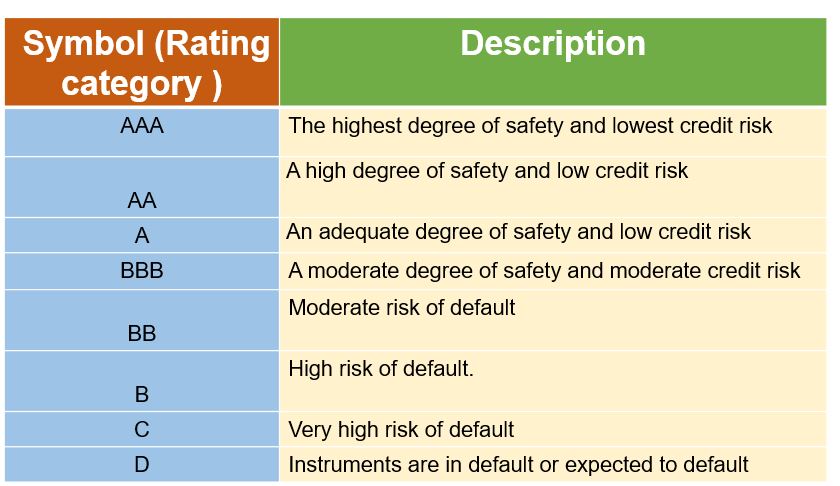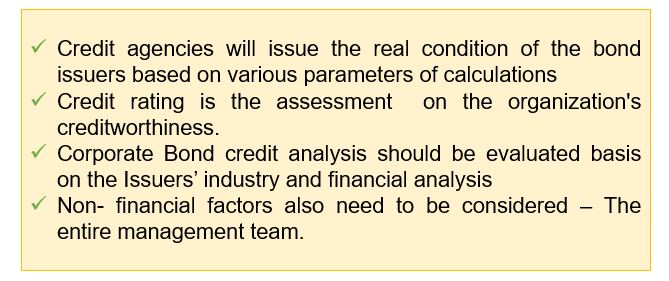The financial market has a unique nature of being consistently unpredictable, and nobody can firmly predict anything in such a volatile market. It is clear that the market has been brought to a halt for the last two years due to Covid-19, even the market leaders could not foresee that this catastrophe would arise and significantly impact the entire market. The market has yet to recover entirely from the impact and has not convinced investors to take a risk on their investment portfolios. Nevertheless, there has been a surge in one of the financial investment instruments, that is bonds, that are being issued by both the government and corporate (G-secs and corporate bonds). Even though the market has witnessed a spike in bonds investment, particularly in corporate bonds investment, investors are still muddled and perplexed about “how to analyse the creditworthiness of corporate bonds” (Bonds issuer). Because of such confusion, a majority of investors are reluctant to consider investing in corporate bonds.
Dwelling in a muddled and perplexed state of mind is not a good sign for both the market and the investors. This article may provide a fundamental way to analyse the credit worthiness of corporate bonds (Bond Issuer) and what are the parameters that need to be considered while analysing the credit.
Let us also understand what is credit rating and its purpose
What is credit rating?
The analysis of financial instruments, particularly debt instruments issued by corporations, governments, entities, organisations, and individuals, is known as credit rating. Simply put, it assesses an organization’s creditworthiness.
Purpose of credit
The investor will be completely aware of the bond issuers and their financial or business capacity while they are issuing bonds. Therefore, credit agencies will issue the real condition of the bond issuers based on various parameters of calculations which would enable the investor to arrive at a conclusion about whether to invest in the particular corporate bonds or not.

A negative (-) sign over any of the rating category represents the chances of degradation in the company’s financial condition.
Credit Rating Agencies in India
Corporate bond credit analysis.
In the beginning, credit analysis focused on the bond’s default risk, which meant that investors might not receive the interest payment on the principal amount. Later, however, the credit analysis took into account the overall economic conditions as well as the possibility that an issuer’s rating would change during the bond’s life.
The investor ought to evaluate the credit worthiness of the corporate bond (bond Issuer) in the following parameters.
1.The issuer industry
The investors primarily need to understand the corporate bonds (Issuer) belong to as this will provide the necessary information to evaluate the specific bond issue. For example, the issuer company may have experienced exponential growth over the year, but the entire industry may be struggling to meet demand or will not have demand in the near future.
Three prominent elements the investors need to consider in the process of analysing the issuers industry.
i) Business cycle
The industry’s business cycle and its relationship to the overall business cycle are important indicators of the specified bonds. It also monitored, how closely does the industry track its country’s rate of growth? Based on the contribution to the country, whether it becomes a necessary product/ business or not, determines the business’s suitability and sustainability in the market.
ii) Market demand
It is necessary to pay attention to the issuer’s industry whether it belongs to high growth and demand sector. Because, a company operating in a high-growth industry is generally regarded as having higher credit quality expectations than one operating in a low-growth environment.
iii) Market crowd(competition)
Credit analysis requires a review of the intensity of competitive forces within an industry, as well as the extent of pricing and over or under-capacity. Competition within an industry is related to the structure of that industry and has implications for pricing flexibility. Pricing policy and relative margins are also influenced by the type of market, such as monopoly, oligopoly, and so on. Another issue arises when there is obvious overcapacity in the industry; for example, during Covid-19, Edu tech companies were on the rise, but after Covid-19, the companies faced many challenges, creating a monopoly market atmosphere, and e-commerce companies have an oligopoly between them.
iv) Political situation
Though corporate and politics are different entities, the political situation has a significant impact on the financial market or particular corporate sectors. The recent war between Ukraine and Russia has had a severe impact on the global economy.
Why should millennials consider investing in Bonds and Debentures
2. Financial analysis
In the beginning the credit analysis was heavily focused on financial analysis but now the analysis has been stretched to how the company operates. The financial analysis has been carried out on the following basis.
a)the ratio analysis for the bonds.
Ratio is analysis the insights of the companies (issuers) operational efficiency, profits and its liquidity. It has been analysed on the following elements.
- Pre-tax income
- Post-tax income (profit)
- How much the company has debt – whether it is a long or short term debt.
- How is the working capital?
- Frequency of the cash flow when compared with competitors.
- Condition of the plant if it is a manufacturing company.
- How much debt instrument principle and interest amount is cleared?
b) analysing the company’s return on capital.
Return on equity is associated with a number of market performance metrics (generally, the analysis focuses on return on capital, or more recently, return on risk adjusted capital. When analysing measures of return, investors need to look for trends in historical performance as well as comparisons with peer group companies.
When comparing the financial performance of companies in the same industry, ROE is used.
It is a measure of management’s ability to generate income from the equity available to it. A return of 15-20% is considered satisfactory. ROE, like other financial ratios, is used when evaluating stocks.
c) non-financial factors such as management expertise and extent of overseas operations.
It is not necessary to only consider the financial side of the corporate, but also the senior management’s strength and competence, as well as the degree of exposure to international markets. The breadth of overseas exposure is not always obvious from documents like the annual report, and analysts may need to conduct additional research to determine this.
Management quality is a subjective, qualitative factor that can be assessed in a variety of ways. Personal familiarity with senior directors, gained over time, may aid in the assessment.
A wide range of experience, age diversity, and fierce internal competition for those aspiring to very senior positions are all considered positive. A company that was founded by a single person and had no clear plans for “succession” could be marked down.
For example – Apple, Microsoft, and Google have been led by the leader who had built their personal brand before stepping into leading the company. We can consider Navi’s Sachin Bansal who has proved himself in Flipkart before leading Navi Finserv.
Therefore, the investor can understand the corporate bond creditworthiness based on the aforementioned parameter which would help to decide whether to purchase the particular bonds or not.
Key Highlights

What is the difference between Corporate and Governments Bonds?






